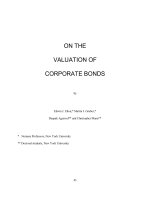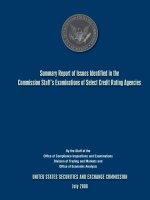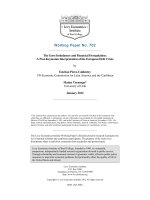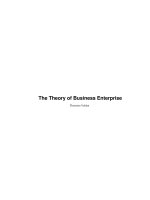Formation of carbon–carbon single bonds pot
Bạn đang xem bản rút gọn của tài liệu. Xem và tải ngay bản đầy đủ của tài liệu tại đây (241.63 KB, 10 trang )
1
Formation of carbon–carbon single bonds
The formation of carbon–carbon single bonds is of fundamental importance in
organic synthesis. As a result, there is an ever-growing number of methods available
for carbon–carbon bond formation. Many of the most useful procedures involve the
addition of organometallic species or enolates to electrophiles, as in the Grignard
reaction, the aldol reaction, the Michael reaction, alkylation reactions and coupling
reactions. Significant advances in both main-group and transition-metal-mediated
carbon–carbon bond-forming reactions have been made over the past decade. Such
reactions, which have been finding useful application, are discussed in this chapter.
The formation of carbon–carbon single bonds by pericyclic or radical reactions are
discussed in chapters 3 and 4.
1.1 Main-group chemistry
1.1.1 Alkylation of enolates and enamines
It is well known that carbonyl groups increase the acidity of the proton(s) adjacent
(␣-) to the carbonyl group. Table 1.1 shows the pK
a
values for some unsaturated
compounds and for some common solvents and reagents.
The acidity of the C
H bonds in these compounds is caused by a combina-
tion of the inductive electron-withdrawing effect of the unsaturated groups and
the resonance stabilization of the anion formed by removal of a proton (1.1).
Not all groups are equally effective in ‘activating’ a neighbouring CH; nitro is
the most powerful of the common groups, with the series following the approxi-
mate order NO
2
>COR>SO
2
R>CO
2
R>CN>C
6
H
5
. Two activating groups rein-
force each other; for example, diethyl malonate has a lower pK
a
(≈13) than ethyl
acetate (pK
a
≈ 24). Acidity is increased slightly by electronegative substituents
1
www.cambridge.org© Cambridge University Press
Cambridge University Press
0521778301 - Modern Methods of Organic Synthesis
W. Carruthers and Iain Coldham
Excerpt
More information
2 Formation of carbon–carbon single bonds
Table 1.1. Approximate acidities of some activated
compounds and common reagents
Compound pK
a
Compound pK
a
CH
3
CO
2
H 5C
6
H
5
COCH
3
19
CH
2
(CN)CO
2
Et 9 CH
3
COCH
3
20
CH
2
(COCH
3
)
2
9CH
3
CO
2
Et 24
CH
3
NO
2
10 CH
3
CN 25
CH
3
COCH
2
CO
2
Et 11 ((CH
3
)
3
Si)
2
NH 26
CH
2
(CO
2
Et)
2
13 CH
3
SO
2
CH
3
31
CH
3
OH 16 CH
3
SOCH
3
35
(CH
3
)
3
COH 19 ((CH
3
)
2
CH)
2
NH 36
(e.g. sulfide) and decreased by alkyl groups.
COEt
OEtC
H
2
C
O
O
COEt
OEtC
C
O
O
COEt
OEtC
C
O
O
HH
COEt
OEtC
C
O
O
H
base
(1.1)
By far the most important activating group in synthesis is the carbonyl group.
Removal of a proton from the ␣-carbon atom of a carbonyl compound with base
gives the corresponding enolate anion. It is these enolate anions that are involved
in many reactions of carbonyl compounds, such as the aldol condensation, and in
bimolecular nucleophilic displacements (alkylations, as depicted in Scheme 1.2).
R
C
H
2
C
R'
O
R
C
C
R'
O
H
R
C
C
R'
O
H
R
C
C
R'
O
H
X
C
R''
HH
C
C
C
R'
O
R''
HH
RH
(1.2)
base
X = leaving group,
e.g.
Br
Enolate anions should be distinguished from enols, which are always present
in equilibrium with the carbonyl compound (1.3). Most monoketones and esters
contain only small amounts of enol (<1%) at equilibrium, but with 1,2- and 1,3-
dicarbonyl compounds much higher amounts of enol (>50%) may be present. In
the presence of a protic acid, ketones may be converted largely into the enol form,
www.cambridge.org© Cambridge University Press
Cambridge University Press
0521778301 - Modern Methods of Organic Synthesis
W. Carruthers and Iain Coldham
Excerpt
More information
1.1 Main-group chemistry 3
implicated in many acid-catalysed reactions of carbonyl compounds.
R
C
H
2
C
R'
O
R
C
C
R'
OH
H
(1.3)
Table 1.1 illustrates the relatively high acidity of compounds in which a C H
bond is activated by two or more carbonyl (or cyano) groups. It is therefore possible
to use a comparatively weak base, such as a solution of sodium ethoxide in ethanol,
in order to form the required enolate anion. An equilibrium is set up, as illustrated
in Scheme 1.4, in which the conjugate acid of the base (BH) must be a weaker acid
than the active methylene compound. Another procedure for preparing the enolate
of an active methylene compound is to use sodium hydride (or finely divided sodium
or potassium metal) in tetrahydrofuran (THF), diethyl ether (Et
2
O) or benzene. The
metal salt of the enolate is formed irreversibly with evolution of hydrogen gas. -
Diketones can often be converted into their enolates with alkali-metal hydroxides
or carbonates in aqueous alcohol or acetone.
–
CH(CO
2
Et)
2
+ BHCH
2
(CO
2
Et)
2
+ B
–
(1.4)
Much faster alkylation of enolate anions can often be achieved in dimethylfor-
mamide (DMF), dimethylsulfoxide (DMSO) or 1,2-dimethoxyethane (DME) than
in the usual protic solvents. The presence of hexamethylphosphoramide (HMPA)
or a triamine or tetramine can also enhance the rate of alkylation. This is thought to
be because of the fact that these solvents or additives solvate the cation, but not the
enolate, thereby separating the cation–enolate ion pair. This leaves a relatively free
enolate ion, which would be expected to be a more reactive nucleophile than the ion
pair.
1
Reactions with aqueous alkali as base are often improved in the presence of
a phase-transfer catalyst such as a tetra-alkylammonium salt.
2
Alkylation of enolate anions is achieved readily with alkyl halides or other alky-
lating agents.
3
Both primary and secondary alkyl, allyl or benzyl halides may
be used successfully, but with tertiary halides poor yields of alkylated product
often result because of competing elimination. It is sometimes advantageous to
proceed by way of the toluene-p-sulfonate, methanesulfonate or trifluoromethane-
sulfonate rather than a halide. The sulfonates are excellent alkylating agents and
can usually be obtained from the alcohol in a pure condition more readily than
1
H. E. Zaugg, D. A. Dunnigan, R. J. Michaels, L. R. Swett, T. S. Wang, A. H. Sommers and R. W. DeNet, J.
Org. Chem., 26 (1961), 644; A. J. Parker, Quart. Rev. Chem. Soc. Lond., 16 (1962), 163; M. Goto, K. Akimoto,
K. Aoki, M. Shindo and K. Koga, Tetrahedron Lett., 40 (1999), 8129.
2
M. Makosza and A. Jonczyk, Org. Synth., 55 (1976), 91.
3
D. Caine, in Comprehensive Organic Synthesis, ed. B. M. Trost and I. Fleming, vol. 3 (Oxford: Pergamon Press,
1991), p. 1.
www.cambridge.org© Cambridge University Press
Cambridge University Press
0521778301 - Modern Methods of Organic Synthesis
W. Carruthers and Iain Coldham
Excerpt
More information
4 Formation of carbon–carbon single bonds
the corresponding halides. Primary and secondary alcohols can be used as alkylat-
ing agents under Mitsunobu conditions.
4
Epoxides have also been used, generally
reacting at the less substituted carbon atom. Attack of the enolate anion on the
alkylating agent takes place by an S
N
2 pathway and thus results in inversion of
configuration at the carbon atom of the alkylating agent (1.5).
5
CO
2
Et
OSO
2
Me
CO
2
Et
CH(CO
2
Et)
2
+
CsF
68%
CH
2
(CO
2
Et)
2
(1.5)
With secondary and tertiary allylic halides or sulfonates, reaction of an enolate
anion may give mixtures of products formed by competing attack at the ␣- and
␥-positions (1.6). Addition of the enolate anion to a -allylpalladium complex
provides an alternative method for allylation (see Section 1.2.4).
Cl CH(CO
2
Et)
2
CH(CO
2
Et)
2
(1.6)
CH
2
(CO
2
Et)
2
+
NaOEt, EtOH
A difficulty sometimes encountered in the alkylation of active methylene com-
pounds is the formation of unwanted dialkylated products. During the alkylation
of the sodium salt of diethylmalonate, the monoalkyl derivative formed initially
is in equilibrium with its anion. In ethanol solution, dialkylation does not take
place to any appreciable extent because ethanol is sufficiently acidic to reduce the
concentration of the anion of the alkyl derivative, but not that of the more acidic
diethylmalonate itself, to a very low value. However, replacement of ethanol by an
inert solvent favours dialkylation. Dialkylation also becomes a more serious prob-
lem with the more acidic cyanoacetic esters and in alkylations with very reactive
electrophiles such as allyl or benzyl halides or sulfonates.
Dialkylation may, of course, be effected deliberately if required by carrying out
two successive operations, by using either the same or a different alkylating agent
in the two steps. Alkylation of dihalides provides a useful route to three- to seven-
membered ring compounds (1.7). Non-cyclic products are formed at the same time
by competing intermolecular reactions and conditions have to be chosen carefully
to suppress their formation (for example, by using high dilution).
CO
2
Et
CO
2
Et
Br Br
+CH
2
(CO
2
Et)
2
NaOEt
n
(1.7)
EtOH
n
n = 0–4
4
O. Mitsunobu, Synthesis (1981), 1; J. Yu, J Y. Lai and J. R. Falck, Synlett (1995), 1127; T. Tsunoda, C. Nagino,
M. Oguri and S. Itˆo, Tetrahedron Lett., 37 (1996), 2459.
5
T. Sato and J. Otera, J. Org. Chem., 60 (1995), 2627.
www.cambridge.org© Cambridge University Press
Cambridge University Press
0521778301 - Modern Methods of Organic Synthesis
W. Carruthers and Iain Coldham
Excerpt
More information
1.1 Main-group chemistry 5
Under ordinary conditions, aryl or alkenyl halides do not react with enolate
anions, although reaction can occur with aryl halides bearing strongly electro-
negative substituents in the ortho and para positions. 2,4-Dinitrochlorobenzene,
for example, with ethyl cyanoacetate gives ethyl (2,4-dinitrophenyl)cyanoacetate
(90%) by an addition–elimination pathway. Unactivated aryl halides may react
with enolates under more vigorous conditions, particularly sodium amide in liquid
ammonia. Under these conditions, the reaction of bromobenzene with diethyl-
malonate, for example, takes place by an elimination–addition sequence in which
benzyne is an intermediate (1.8).
CO
2
Et
CO
2
Et
liq. NH
3
NaNH
2
–
CH(CO
2
Et)
2
(1.8)
PhCH(CO
2
Et)
2
50%
Br
Enolate anions with extended conjugation can be formed by proton abstraction
of ␣,-unsaturated carbonyl compounds (1.9). Kinetically controlled alkylation of
the delocalized anion takes place at the ␣-carbon atom to give the ,␥-unsaturated
compound directly. A similar course is followed in the kinetically controlled pro-
tonation of such anions.
CN
CO
2
Et
CN
CO
2
Et
CN
CO
2
Et
CN
Me
CO
2
Et
(1.9)
NaOEt
EtOH
MeI
A wasteful side reaction which sometimes occurs in the alkylation of 1,3-
dicarbonyl compounds is the formation of the O-alkylated product. For example,
reaction of the sodium salt of cyclohexan-1,3-dione with butyl bromide gives the
O-alkylated product (37%) and only 15% of the C-alkylated 2-butylcyclohexan-1,3-
dione. In general, however, O-alkylation competes significantly with C-alkylation
only with reactive methylene compounds in which the equilibrium concentration
of enol is relatively high (as in 1,3-dicarbonyl compounds). The extent of C- versus
O-alkylation for a particular 1,3-dicarbonyl compound depends on the choice of
cation, solvent and electrophile. Cations (such as Li
+
) that are more covalently
bound to the enolate oxygen atom or soft electrophiles (such as alkyl halides)
favour C-alkylation, whereas cations such as K
+
or hard electrophiles (such as
alkyl sulfonates) favour O-alkylation.
www.cambridge.org© Cambridge University Press
Cambridge University Press
0521778301 - Modern Methods of Organic Synthesis
W. Carruthers and Iain Coldham
Excerpt
More information
6 Formation of carbon–carbon single bonds
Alkylation of malonic esters and other active methylene compounds is useful
in synthesis because the alkylated products can be subjected to hydrolysis and
decarboxylation (1.10). Direct decarboxylation under neutral conditions with an
alkali metal salt (e.g. lithium chloride) in a dipolar aprotic solvent (e.g. DMF) is a
popular alternative method.
6
RCH
2
CO
2
Et
RCH(CO
2
Et)
2
R–X
i, NaOH
CH
2
(CO
2
Et)
2
NaOEt, EtOH
RCH
2
CO
2
H
(1.10)
ii, H
3
O
+
, heat
LiCl
DMF
Proton abstraction from a monofunctional carbonyl compound (aldehyde,
ketone, ester, etc.) is more difficult than that from a 1,3-dicarbonyl compound.
Table 1.1 illustrates that a methyl or methylene group which is activated by only
one carbonyl or cyano group requires a stronger base than ethoxide or methoxide
ion to convert it to the enolate anion in high enough concentration to be useful for
subsequent alkylation. Alkali-metal salts of tertiary alcohols, such as tert-butanol,
in the corresponding alcohol or an inert solvent, have been used with success,
but suffer from the disadvantage that they are not sufficiently basic to convert the
ketone completely into the enolate anion. This therefore allows the possibility of
an aldol reaction between the anion and unchanged carbonyl compound. An alter-
native procedure is to use a much stronger base that will convert the compound
completely into the anion. Traditional bases of this type are sodium and potassium
amide or sodium hydride, in solvents such as diethyl ether, benzene, DME or DMF.
The alkali-metal amides are often used in solution in liquid ammonia. Although
these bases can convert ketones essentially quantitatively into their enolate anions,
aldol reaction may again be a difficulty with these bases because of the insolubility
of the reagents. Formation of the anion takes place only slowly in the heteroge-
neous reaction medium and both the ketone and the enolate ion are present at some
stage. This difficulty does not arise with the lithium dialkylamides, such as lithium
diisopropylamide (LDA) or lithium 2,2,6,6-tetramethylpiperidide (LTMP) or the
alkali-metal salts of bis(trimethylsilyl)amine (LHMDS, NaHMDS and KHMDS),
which are soluble in non-polar solvents. These bases are now the most commonly
used reagents for the generation of enolates.
An example illustrating the intermolecular alkylation of an ester is given in
Scheme 1.11. Intramolecular alkylations also take place readily in appropriate cases
and reactions of this kind have been used widely in the synthesis of cyclic com-
pounds. In such cases, the electrophilic centre generally approaches the enolate
6
A. P. Krapcho, Synthesis (1982), 805; 893.
www.cambridge.org© Cambridge University Press
Cambridge University Press
0521778301 - Modern Methods of Organic Synthesis
W. Carruthers and Iain Coldham
Excerpt
More information
1.1 Main-group chemistry 7
from the less-hindered side and in a direction orthogonal to the plane of the enolate
anion.
CO
2
Me
Br
CO
2
Me CO
2
Me
i, LiN
i
Pr
2
(LDA)
THF, –78 °C THF, –78 °C
i, LDA
ii, EtBr
90%
ii,
(1.11)
A common problem in the direct alkylation of ketones is the formation of di- and
polyalkylated products. This difficulty can be avoided to some extent by adding
a solution of the enolate in a polar co-ordinating solvent such as DME to a large
excess of the alkylating agent. The enolate may therefore be consumed rapidly
before equilibration with the alkylated ketone can take place. Nevertheless, for-
mation of polysubstituted products is a serious problem in the direct alkylation of
ketones and often results in decreased yields of the desired monoalkyl compound.
An explanation for the presence of considerable amounts of polyalkylated prod-
uct(s) is that enolates of alkylated ketones are less highly aggregated in solution and
hence more reactive.
7
Some solutions to this problem use the additive dimethylzinc
8
or the manganese enolate of the ketone.
9
Good yields of the monoalkylated products
have been obtained under these conditions (1.12).
O OMnX O
Me
(1.12)
MnCl
2
or MnBr
2
LDA or LHMDS MeI
76%
Alkylation of symmetrical ketones or of ketones that can enolize in one direction
only can, of course, give just one mono-C-alkylated product. With unsymmetrical
ketones, however, two different monoalkylated products may be formed by way of
the two structurally isomeric enolate anions. If one of the isomeric enolate anions
is stabilized by conjugation with another group, such as cyano, nitro or a carbonyl
group, then only this stabilized anion is formed and alkylation takes place at the
position activated by both groups. Even a phenyl or an alkenyl group provide
sufficient stabilization of the resulting anion to direct substitution into the adjacent
7
A. Streitwieser, Y. J. Kim, and D. Z. R. Wang, Org. Lett., 3 (2001), 2599.
8
Y. Morita, M. Suzuki and R. Noyori, J. Org. Chem., 54 (1989), 1785.
9
M. T. Reetz and H. Haning, Tetrahedron Lett., 34 (1993), 7395; G. Cahiez, B. Figad`ere and P. Cl´ery, Tetrahedron
Lett., 35 (1994), 3065; G. Cahiez, K. Chau and P. Cl´ery, Tetrahedron Lett., 35 (1994), 3069; G. Cahiez, F. Chau
and B. Blanchot, Org. Synth., 76 (1999), 239.
www.cambridge.org© Cambridge University Press
Cambridge University Press
0521778301 - Modern Methods of Organic Synthesis
W. Carruthers and Iain Coldham
Excerpt
More information
8 Formation of carbon–carbon single bonds
position (1.13).
10
Ph
O
Ph
O
Ph
O
Me
Me
95%
100 : 0
KOH, Bu
4
NBr
+
MeI
(1.13)
Sometimes, specific lithium enolates of unsymmetrical carbonyl compounds are
formed because of chelation of the lithium atom with a suitably placed substituent.
For example, lithiation and alkylation of the mixed ester 1 took place ␣-tothe
MEM ester group, presumably as a result of intramolecular chelation of the lithium
atom with the ethereal oxygen atom (1.14).
11
CO
2
MeMEMO
2
C CO
2
MeMEMO
2
C
Ph
MEM = CH
3
OCH
2
CH
2
OCH
2
–
1
i, LDA, THF
(1.14)
ii, PhCH
2
Cl
57%
Alkylation of unsymmetrical ketones bearing ␣-alkyl substituents generally leads
to mixtures containing both ␣-alkylated products. The relative amount of the two
products depends on the structure of the ketone and may also be influenced by
experimental factors, such as the nature of the cation and the solvent (see Table 1.2).
In the presence of the ketone or a protic solvent, equilibration of the two enolate
anions can take place. Therefore, if the enolate is prepared by slow addition of
the base to the ketone, or if an excess of the ketone remains after the addition of
base is complete, the equilibrium mixture of enolate anions is obtained, containing
predominantly the more-substituted enolate. Slow addition of the ketone to an
excess of a strong base in an aprotic solvent, on the other hand, leads to the kinetic
mixture of enolates; under these conditions the ketone is converted completely into
the anion and equilibration does not occur.
The composition of mixtures of enolates formed under kinetic conditions differs
from that of mixtures formed under equilibrium conditions. The more-acidic, often
less-hindered, ␣-proton is removed more rapidly by the base (e.g. LDA), result-
ing in the less-substituted enolate under kinetic conditions. Under thermodynamic
conditions, the more-substituted enolate normally predominates. Mixtures of both
structurally isomeric enolates are generally obtained and mixtures of products result
on alkylation. Di- and trialkylated products may also be formed and it is not always
10
A. Aranda, A. D´ıaz, E. D´ıez-Barra, A. de la Hoz, A. Moreno and P. S´anchez-Verd´u, J. Chem. Soc., Perkin
Trans. 1 (1992), 2427.
11
M. T. Cox, D. W. Heaton and J. Horbury, J. Chem. Soc., Chem. Commun. (1980), 799.
www.cambridge.org© Cambridge University Press
Cambridge University Press
0521778301 - Modern Methods of Organic Synthesis
W. Carruthers and Iain Coldham
Excerpt
More information
1.1 Main-group chemistry 9
Table 1.2. Composition of enolate anions generated from the ketone and a base
Ketone Base (conditions) Enolate anion composition (%)
O
Me
O
–
Me
O
–
Me
LDA, DME, −78
◦
C
(kinetic control)
199
Ph
3
CLi, DME, −78
◦
C
(kinetic control)
991
Ph
3
CLi, DME
(equilibrium control)
90 10
t-BuOK, t-BuOH
(equilibrium control)
93 7
O
O
–
O
–
LDA, THF, −78
◦
C
(kinetic control)
0 100
Ph
3
CLi, DME
(equilibrium control)
87 13
easy to isolate the pure monoalkylated compound. This is a serious problem in
synthesis as it results in the loss of valuable starting materials.
A number of methods have been used to improve selectivity in the alkylation of
unsymmetrical ketones and to reduce the amount of polyalkylation. One procedure
is to introduce temporarily an activating group at one of the ␣-positions to stabi-
lize the corresponding enolate anion; this group is removed after the alkylation.
Common activating groups used for this purpose are ester groups. For example,
2-methylcyclohexanone can be prepared from cyclohexanone as shown in Scheme
1.15. The 2-ethoxycarbonyl derivative is obtained from the ketone by reaction with
diethyl carbonate (or by reaction with diethyl oxalate followed by decarbonyla-
tion). Conversion to the enolate anion with a base such as sodium ethoxide takes
place exclusively at the doubly activated position. Methylation with iodomethane
and removal of the -ketoester group with acid gives 2-methylcyclohexanone, free
from polyalkylated products.
OO
CO
2
Et
O
CO
2
Et
Me
O
Me
NaOEt
EtOH
CO(OEt)
2
LiCl, DME
MeI
(1.15)
NaOEt
EtOH
HCl, heat
or
www.cambridge.org© Cambridge University Press
Cambridge University Press
0521778301 - Modern Methods of Organic Synthesis
W. Carruthers and Iain Coldham
Excerpt
More information
10 Formation of carbon–carbon single bonds
Another technique is to block one of the ␣-positions by introduction of a remov-
able substituent which prevents formation of the corresponding enolate. Selective
alkylation can be performed after acylation with ethyl formate and transformation
of the resulting formyl (or hydroxymethylene) substituent into a group that is sta-
ble to base, such as an enamine, an enol ether or an enol thioether. An example of
this procedure is shown in Scheme 1.16, in the preparation of 9-methyl-1-decalone
from trans-1-decalone. Direct alkylation of this compound gives mainly the 2-alkyl
derivative, whereas blocking the 2-position allows the formation of the required
9-alkyl-1-decalone (as a mixture of cis and trans isomers).
O
H
H
O
H
H
Me
O
H
H
CHSBu
O
Me
H
CHSBu
O
Me
H
t
BuOK
MeI
(1.16)
t
BuOK,
t
BuOH
ii, BuSH, TsOH
major product
i, NaOEt, EtOH
HCO
2
Et
KOH
H
2
O
ethylene
glycol, reflux
t
BuOH
MeI
Alkylation of a 1,3-dicarbonyl compound at a ‘flanking’ methyl or methylene
group instead of at the doubly activated C-2 position does not usually take place to
any significant extent. It can be accomplished selectively and in good yield, however,
by way of the corresponding dianion, itself prepared from the dicarbonyl compound
and two equivalents of a suitable strong base. For example, 2,4-pentanedione 2 is
converted into 2,4-nonanedione by reaction at the more-reactive, less-resonance-
stabilized carbanion (1.17).
12
(1.17)
OOOO
OO
2
C
4
H
9
Br
then H
3
O
+
NH
3 (l)
2 equiv. KNH
2
With unsymmetrical dicarbonyl compounds that could give rise to two different
dianions, it is found that in most cases only one is formed and a single product
results on alkylation. Thus, with 2,4-hexanedione alkylation at the methyl group
greatly predominates over that at the methylene group, and 2-acetylcyclohexanone
and 2-acetylcyclopentanone are both alkylated exclusively at the methyl group. In
general, the ease of alkylation follows the order C
6
H
5
CH
2
>CH
3
>CH
2
.
12
T. M. Harris and C. M. Harris, Org. Reactions, 17 (1969), 155.
www.cambridge.org© Cambridge University Press
Cambridge University Press
0521778301 - Modern Methods of Organic Synthesis
W. Carruthers and Iain Coldham
Excerpt
More information









